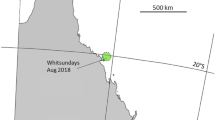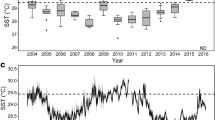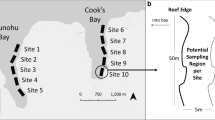Abstract
Benthic cyanobacteria can respond rapidly to favorable environmental conditions, overgrow a variety of reef organisms, and dominate benthic marine communities; however, little is known about the dynamics and consequences of such cyanobacterial blooms in coral reef ecosystems. In this study, the benthic community was quantified at the time of coral spawnings in Guam to assess the substrate that coral larvae would encounter when attempting settlement. Transects at 9, 18, and 25-m depths were surveyed at two reef sites before and after heavy wave action driven by westerly monsoon winds. Communities differed significantly between sites and depths, but major changes in benthic community structure were associated with wave action driven by monsoon winds. A shift from cyanobacteria to crustose coralline algae (CCA) accounted for 44% of this change. Coral recruitment on Guam may be limited by substrate availability if cyanobacteria cover large areas of the reef at the time of settlement, and consequently recruitment may in part depend upon wave action from annual monsoon winds and tropical storms which remove cyanobacteria, thereby exposing underlying CCA and other substrate suitable for coral settlement.



Similar content being viewed by others
References
Adey WH, Burke RB (1977) Holocene bioherms of Lesser Antilles: geologic control of development. American Association of Petroleum Geologists. Stud Geol 4:67–81
Aronson RB, Precht WF (1997) Stasis, biological disturbance, and community structure of a Holocene coral reef. Paleobiology 23:326–346
Aronson RB, Precht WF (2000) Herbivory and algal dynamics on the coral reef at Discovery Bay, Jamaica. Limnol Oceanogr 45:251–255
Asami R, Yamada T, Iryu Y, Meyer CP, Quinn TM, Paulay G (2004) Carbon and oxygen isotopic composition of a Guam coral and their relationships to environmental variables in the western Pacific. Palaeogeogr Palaeocl 212:1–22
Birkeland C (1977) The importance of rate of biomass accumulation in early successional stages of benthic communities to the survival of coral recruits. In: Proceedings of 3rd international coral reef symposium 2:15–21
Birkeland C (1988) Geographic comparisons of coral-reef community processes. In: Proceedings of 3rd international coral reef symposium 1:211–220
Blanchon P, Perry CT (2004) Taphonomic differentiation of Acropora palmata facies in cores from Campeche Bank Reefs, Gulf of México. Sedimentology 51:53–76
Brown BE (1997) Adaptations of reef corals to physical environmental stress. Adv Mar Biol 31:221–299
Caley MJ, Carr MH, Hixon MA, Hughes TP, Jones GP, Menge BA (1996) Recruitment and the local dynamics of open marine populations. Annu Rev Ecol Syst 27:477–500
Cheroske AG, Williams SL, Carpenter RC (2000) Effects of physical and biological disturbances on algal turfs in Kaneohe Bay, Hawaii. J Exp Mar Biol Ecol 248:1–34
Clarke KR, Warwick RM (2001) Change in marine communities: an approach to statistical analysis and interpretation. 5 Primer-E Ltd, Plymouth Marine Laboratory, Plymouth
Cowell BC, Botts PS (1994) Factors influencing the distribution, abundance and growth of Lyngbya wollei in central Florida. Aquat Bot 49:1–17
Dollar SJ (1982) Wave stress and coral community structure in Hawaii. Coral Reefs 1:71–81
Dollar SJ, Tribble GW (1993) Recurrent storm disturbance and recovery: a long-term study of coral communities in Hawaii. Coral Reefs 12:223–233
Doyle RD, Smart RM (1998) Competitive reduction of noxius Lyngbya wollei mats by rooted aquatic plants. Aquat Bot 61:17–32
Dudgeon SR, Johnson AS (1992) Thick versus thin: thallus morphology and tissue mechanics influence differential drag and dislodgement of two co-dominant seaweeds. J Exp Mar Biol Ecol 165:23–43
Elmetri I, Bell PRF (2004) Effects of phosphorus on the growth and nitrogen fixation rates of Lyngbya majuscula: implications for management in Moreton Bay, Queensland. Mar Ecol-Prog Ser 281:27–35
FitzGerald WJ Jr (1978) Environmental parameters influencing the growth of Enteromorpha clathrata (Roth) J. A. in the intertidal zone on Guam. Bot Mar 21:207–220
Gardner TA, Coté IM, Gill JA, Grant A, Watkinson AR (2003) Long-term region-wide declines in Caribbean corals. Science 301:958–960
Glassom D, Zakai D, Chadwick-Furman NE (2004) Coral recruitment: a spatio-temporal analysis along the coastline of Eilat, northern Red Sea. Mar Biol 144:641–651
Harrington L, Fabricius K, De’ath G, Negri A (2004) Recognition and selection of settlement substrata determine post-settlement survival in corals. Ecology 85:3428–3437
Hay ME (1981) The functional morphology of turf-forming seaweeds: persistence in stressful marine habitats. Ecology 62:739–750
Hay ME (1984) Patterns of fish and urchin grazing on Caribbean reefs: are previous results typical? Ecology 65:739–750
Heyward AJ, Negri AP (1999) Natural inducers for coral larval metamorphosis. Coral Reefs 18:273–279
Hughes TP (1989) Community structure and diversity of coral reefs: the role of history. Ecology 70:275–279
Hughes TP (1994) Catastrophes, phase shifts, and large-scale degradation of a Caribbean coral reef. Science 265:1547–1551
Hughes TP, Baird AH, Bellwood DR, Card M, Connolly SR, Folke C, Grosberg R, Hoegh-Guldberg O, Jackson JBC, Kleypas J, Lough JM, Marshall P, Nyström M, Palumbi SR, Pandolfi JM, Rosen B, Roughgarden J (2003) Climate change, human impacts, and the resilience of coral reefs. Science 301:929–933
Kingsbury JM (1962) The effect of waves on the composition of a population of marine attached algae. Bull Torrey Bot Club 89:143–160
Kuffner IB, Paul VJ (2001) Effects of nitrate, phosphate and iron on the growth of macroalgae and benthic cyanobacteria from Cocos Lagoon, Guam. Mar Ecol-Prog Ser 222:63–72
Kuffner IB, Paul VJ (2004) Effects of the cyanobacterium Lyngbya majuscula on larval recruitment of the reef corals Acropora surculosa and Pocillopora damicornis. Coral Reefs 23:455–458
Lapointe BE (1997) Nutrient thresholds for bottom-up control of macroalgal blooms on coral reefs in Jamaica and southeast Florida. Limnol Oceanogr 42:1119–1131
Lapointe BE (1999) Simultaneous top-down and bottom-up forces control macroalgal blooms on coral reefs. Limnol Oceanogr 44:1586–1592
Lessios HA (1988) Mass mortality of Diadema antillarum in the Caribbean: what have we learned? Annu Rev Ecol Syst 19:371–393
Lirman D (2001) Competition between macroalgae and corals: effects of herbivore exclusion and increased algal biomass on coral survivorship and growth. Coral Reefs 19:392–399
Littler MM, Littler DS (1984) Models of tropical reef biogenesis: the contribution of algae. In: Round FE, Chapman DJ (eds) Progress in Phycological Research 3:323–364
McClanahan TR, Muthiga NA (1998) An ecological shift in a remote coral atoll of Belize over 25 years. Environ Conserv 25:122–130
McCook LJ (1999) Macroalgae, nutrients and phase shifts on coral reefs: scientific issues and management consequences for the Great Barrier Reef. Coral Reefs 18:357–367
McCook LJ (2001) Competition between corals and algal turfs along a gradient of terrestrial influence in the nearshore central Great Barrier Reef. Coral Reefs 19:419–425
McCook LJ, Jompa J, Diaz-Pullido G (2001) Competition between corals and algae on coral reefs: a review of evidence and mechanisms. Coral Reefs 19:400–417
Miller MW, Hay ME (1996) Coral-seaweed-grazer-nutrient interactions on temperate reefs. Ecol Monogr 66:323–344
Miller MW, Hay ME (1998) Effects of fish predation and seaweed competition on the survival and growth of corals. Oecologia 113:231–238
Miller MW, Weil E, Szmant AM (2000) Coral recruitment and juvenile mortality as structuring factors for reef benthic communities in Biscayne National Park, USA. Coral Reefs 19:115–123
Morse ANC, Morse DE (1996) Flypapers for coral and other planktonic larvae. Bioscience 46:254–262
Morse ANC, Iwao K, Baba M, Shimoike K, Hayashibara T, Omori M (1996) An ancient chemosensory mechanism brings new life to coral reefs. Biol Bull 191:149–154
Nagle DG, Paul VJ (1999) Production of secondary metabolites by filamentous tropical marine cyanobacteria: ecological functions of the compounds. J Phycol 35:1412–1421
Nystrom M, Folke C, Moberg F (2000) Coral reef disturbance and resilience in a human-dominated environment. Trends Ecol Evol 15:413–417
Paul VJ, Cruz-Rivera E, Thacker RW (2001) Chemical mediation of macroalgal-herbivore interactions: ecological and evolutional perspectives. In: McClintock J, Baker B (eds) Marine chemical ecology. CRC Press, Boca Raton, pp 227–265
Palmer AE (2003) Seasonality of macroalgae and benthic cyanobacteria on reef flats of Guam. MS Thesis, University of Guam, 45 pp
Palmer MA, Allan JD, Butman CA (1996) Dispersal as a regional process affecting the local dynamics of marine and stream benthic invertebrates. Trends Ecol Evol 11:322–326
Palumbi SR (1984) How body plans limit acclimation: responses of a demosponge to wave force. Ecology 67:208–214
Palumbi SR (1986) Tactics of acclimation: morphological changes of sponges in an unpredictable environment. Science 225:1478–1480
Pandolfi JM, Bradbury RH, Sala E, Hughes TP, Bjorndal KA, Cooke RG, McArdle D, McClenachan L, Newman MJH, Paredes G, Warner RR, Jackson JBC (2003) Global trajectories of the long-term decline of coral reef ecosystems. Science 301:955–958
Pennings SC, Pablo SR, Paul VJ (1997) Chemical defenses of the tropical benthic cyanobacterium Hormothamniom enteromorphoides: diverse consumers and synergisms. Limnol Oceanogr 42:911–917
Richmond RH (1988) Competency and dispersal potential of planula larvae of a spawning versus a brooding coral. In: Proceedings of 6th international coral reef symposium 2:827–832
Richmond RH, Hunter CL (1990) Reproduction and recruitment of corals: comparisons among the Caribbean, the tropical Pacific, and the Red Sea. Mar Ecol Prog Ser 60:185–203
Rosen BR (1975) The distribution of reef corals. Report of the Underwater Association 1:1–16
Sale PF (2004) Connectivity, recruitment variation, and the structure of reef fish communities. Integr Comp Biol 44:390–399
Sale PF, Danilowicz BS, Doherty PJ, Williams DM (2005) The relation of microhabitat to variation in recruitment of young-of-year coral reef fishes. Bull Mar Sci 76:123–142
Sandin SA, Pacala SW (2005) Demographic theory of coral reef fish populations with stochastic recruitment: comparing sources of population regulation. Am Nat 165:107–119
Shulman MJ, Robertson DR (1996) Changes in the coral reefs of San Blas, Caribbean Panamá: 1983 to 1990. Coral Reefs 15:231–236
Steneck RS, Dethier MN (1994) A functional group approach to the structure of algal-dominated communities. Oikos 69:476–498
Thacker RW, Paul VJ (2001) Are benthic cyanobacteria indicators of nutrient enrichment? Relationships between cyanobacterial abundance and environmental factors on the reef flats of Guam. Bull Mar Sci 69:497–508
Thacker RW, Nagle DG, Paul VJ (1997) Effects of repeated exposures to marine cyanobacterial secondary metabolites on feeding by juvenile rabbitfish and parrotfish. Mar Ecol Prog Ser 147:21–29
Thacker RW, Ginsburg DW, Paul VJ (2001) Effects of herbivore exclusion and nutrient enrichment on coral reef macroalgae and cyanobacteria. Coral Reefs 19:318–329
Wolanski E, Richmond RH, Davis G, Bonito V (2003) Water and fine sediment dynamics in transient river plumes in a small, reef-fringed bay, Guam. Estuar Coast Shelf S 56:1029–1040
Acknowledgements
We thank Mark A Lander from the Water and Environmental Research Institute of the Western Pacific (WERI), University of Guam, for kindly providing the data on wind speeds and directions. We also thank Raphael Ritson-Williams for his help with fieldwork. Comments from two anonymous reviewers and the editorial team (Kathleen Sullivan Sealey, Richard Dunne, and Barbara Brown) helped improve the manuscript. This is contribution number 134 of the US ECOHAB program, 576 of the University of Guam Marine Laboratory, and 617 of the Smithsonian Marine Station at Fort Pierce. This work was partially supported by the US Environmental Protection Agency grant R82-6620 through the ECOHAB program, but it does not necessarily reflect the views of the Agency.
Author information
Authors and Affiliations
Corresponding author
Additional information
Communicated by Biology Editor K. Sullivan Sealey
Rights and permissions
About this article
Cite this article
Becerro, M.A., Bonito, V. & Paul, V.J. Effects of monsoon-driven wave action on coral reefs of Guam and implications for coral recruitment. Coral Reefs 25, 193–199 (2006). https://doi.org/10.1007/s00338-005-0080-7
Received:
Accepted:
Published:
Issue Date:
DOI: https://doi.org/10.1007/s00338-005-0080-7




